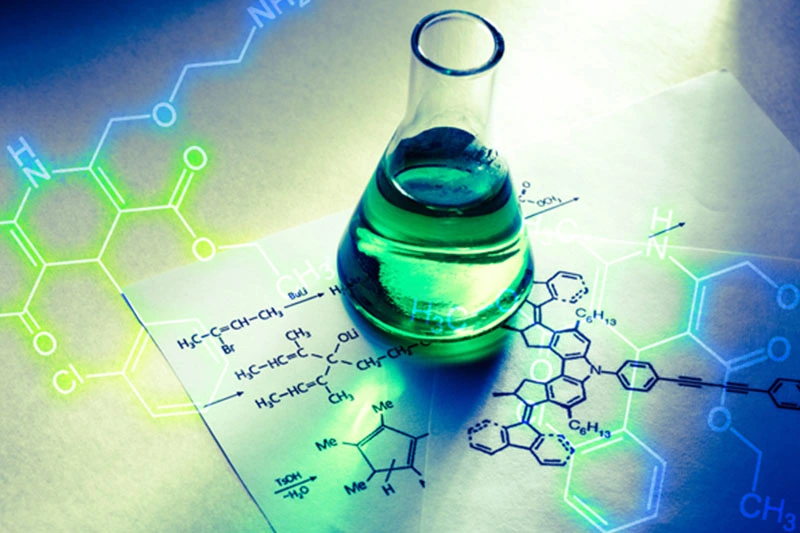
Organic Chemistry for Engineers
Main topics of this course are concerning organic nomenclature, chemical bonding including resonance concept and acid-base concept, organic functional groups, and the relationship between structures of molecules, physical properties and chemical properties of organic compounds. The structure topics discuss on chemical bonding, covalent bond properties that related to the static aspect of molecules (including stereochemistry) as well as its dynamic aspect (conformation). The physical properties topic includes the state of materials, solubility, melting point and boiling points; the chemical properties topic includes acid-base properties, oxidation and reduction reaction, electrophylic and nucleophylic addition reaction, electrophylic and nucleophylic substitution reaction, elimination and free-radical reaction especially halogenation reaction. Other topics are concerning the application of organic chemistry knowledge in understanding of the application of organic compounds and reactions in living organism as well as in industrial applications.
References:
- Fessenden, R. J., & Fessenden, J. S. (1982). Organic Chemistry (2nd ed.). PES Publishers.
- Solomons, T. W. G., Fryhle, C. B., & Snyder, S. A. (2014). Organic Chemistry (11th ed.). John Wiley & Sons, Inc.
Course Fee
Reviews
Schedule
Appointment with tutor(s)
Registration
Atoms and Molecules
This session includes materials about:
- Electron Structure, Atomic Radius, and Electronegativity
- Introduction to Chemical Bond
- Chemical Formulas in Organic Chemistry
- Bond Lengths and Bond Angles
- Bond Dissociation Energy
- Polar Covalent Bonds and Attraction Between Molecules
- Acid and Bases
Orbitals
This session includes materials about:
- Properties of Waves
- Bonding in Hydrogen
- Hybrid Orbitals of Carbon
- Functional Groups
- Hybrid Orbitals of Nitrogen and Oxygen
- Conjugated Double Bonds
- Resonance
Isomers, Nomenclature, and Alkanes
This session includes materials about:
- Structural Isomers
- Organic Nomenclature
- Alkanes
- Hydrocarbon Resources
Stereochemistry
This session includes materials about:
- Geometric Isomerism in Alkenes
- Geometric Isomerism in Cyclic Compounds
- Conformations of Open-Chain Compounds
- Shapes of Cyclic Compounds
- Chirality
Alkyl Halides
This session includes materials about:
- Bonding in Organohalogens Compounds
- Physical Properties of Halogenated Alkanes
- Nomenclature and Classification of Alkyl Halides
- Substitution and Elimination Reactions
- The SN2 and SN1 Reactions
- Substitution Reactions of Allylic Halides and Benzylic Halides
- The E1 and E2 Reactions
Alkenes and Alkynes: Part 1
This session includes materials about:
- Bonding in Alkenes and alkynes
- Physical Properties and Nomenclature of alkenes and Alkynes
- Spectra of Alkenes and Alkynes
- Preparation of Alkenes and Alkynes
- Preview of Addition Reactions
- Addition of Hydrogen Halides to Alkenes and Alkynes
- Addition of H2SO4 and H2O to Alkenes and Alkynes
Alkenes and Alkynes: Part 2
This session includes materials about:
- Hydration Using Mercuric Acetate
- Addition of Borane to Alkenes
- Addition of Halogens to Alkenes and Alkynes
- Addition of Carbenes to Alkenes
- Catalytic Hydrogenation
- Oxidation of Alkenes
- Use of Alkenes and Alkynes in Synthesis
Alcohols, Ethers, and Related Compounds: Part 1
This session includes materials about:
- Bonding in Alcohols and Ethers
- Physical Properties and Nomenclature of Alcohols and Ethers
- Preparation and Reactivity of Alcohols
- Substitution Reactions of Alcohols
- Elimination Reactions of Alcohols
Alcohols, Ethers, and Related Compounds: Part 2
This session includes materials about:
- Alcohols as Acids
- Alkoxides and Phenoxides
- Esterification Reactions
- Inorganic Esters of Alcohols
- Oxidation of Alcohols
- Preparation of Ethers
- Substitution Reactions of Ehters and Epoxides
- Thiols and Sulfieds
- Use of Alcohols and Ethers in Synthesis
Aromaticity, Benzene, and Substituted Benzenes: Part 1
This session includes materials about:
- Nomenclature of Substituted Benzenes
- Physical Properties of Aromatic hydrocarbons
- Spectra of Substituted Benzenes
- Stability of the Benzene Ring
- The Bonding in Benzene
- Preview of Aromatic Compound
- Requirements for Aromaticity
Aromaticity, Benzene, and Substituted Benzenes: Part 2
This session includes materials about:
- Electrophilic Aromatic Substitution
- The First Substitution
- The Second Substitution
- The Third Substitution
- Alkylbenzenes
- Phenols
- Halobenzenes and Nucleophilic Aromatic Substitution
- Synthesis Using Benzene Compunds
Aldehydes and Ketones: Part 1
This session includes materials about:
- Nomenclature of Aldehydes and Ketones
- Preparation of Aldehydes and Ketones
- The Carbonyl Group
- Physical and Spectral Properties of Aldehydes and Ketones
- Addition of Reagents to the Carbonyl Group
- Reaction with Water, Alcohols, Hydrogen Cyanide
Aldehydes and Ketones: Part 2
This session includes materials about:
- Reaction with ammonia and Amines
- Reaction with Hydrazine and Related Compounds
- The Wittig Reaction
- Reaction with Grignard Reagents
- Reduction and Oxidation of Aldehydes and Ketones
- Reactivity of the Alpha Hydrogens
- Use of Aldehydes and Ketones in Synthesis
Carboxylic Acids
This session includes materials about:
- Nomenclatyre of Carboxylic Acids
- Physical and Spectral Properties of Carboxylic Acids
- Preparation of Carboxylic Acids
- Acidity of Carboxylic Acids
- Salts of Carboxylic Acids
- Effect of Structure to Acid Strength
- Esterification, Reduction, and Polyfunctional of Carboxylic Acids
- Use of Carboxylic Acids in Synthesis
Derivatives of Carboxylic Acids
This session includes materials about:
- Reactivity of Carboxylic Acid Derivatives
- Special Properties of Carboxylic Acid Dervatives
- Acid Halides
- Anhydrides of Carboxylic Acids
- Ester of Carboxylic Acids
- Lactones, Polyesters, Thioesters, Amides, Polyamides, and Nitriles
- Use of Carboxylic Acid Derivatives in Synthesis
Amines
This session includes materials about:
- Classification and Nomenclature of Amines
- Bonding in Amines
- Physical and Spectral Properties of Amines
- Preparation of Amines
- Basicity of Amines
- Amine Salts
- Reactions of Amines with Nitrous Acid
- Hofmann Elimination
- Use of Amines in Synthesis


